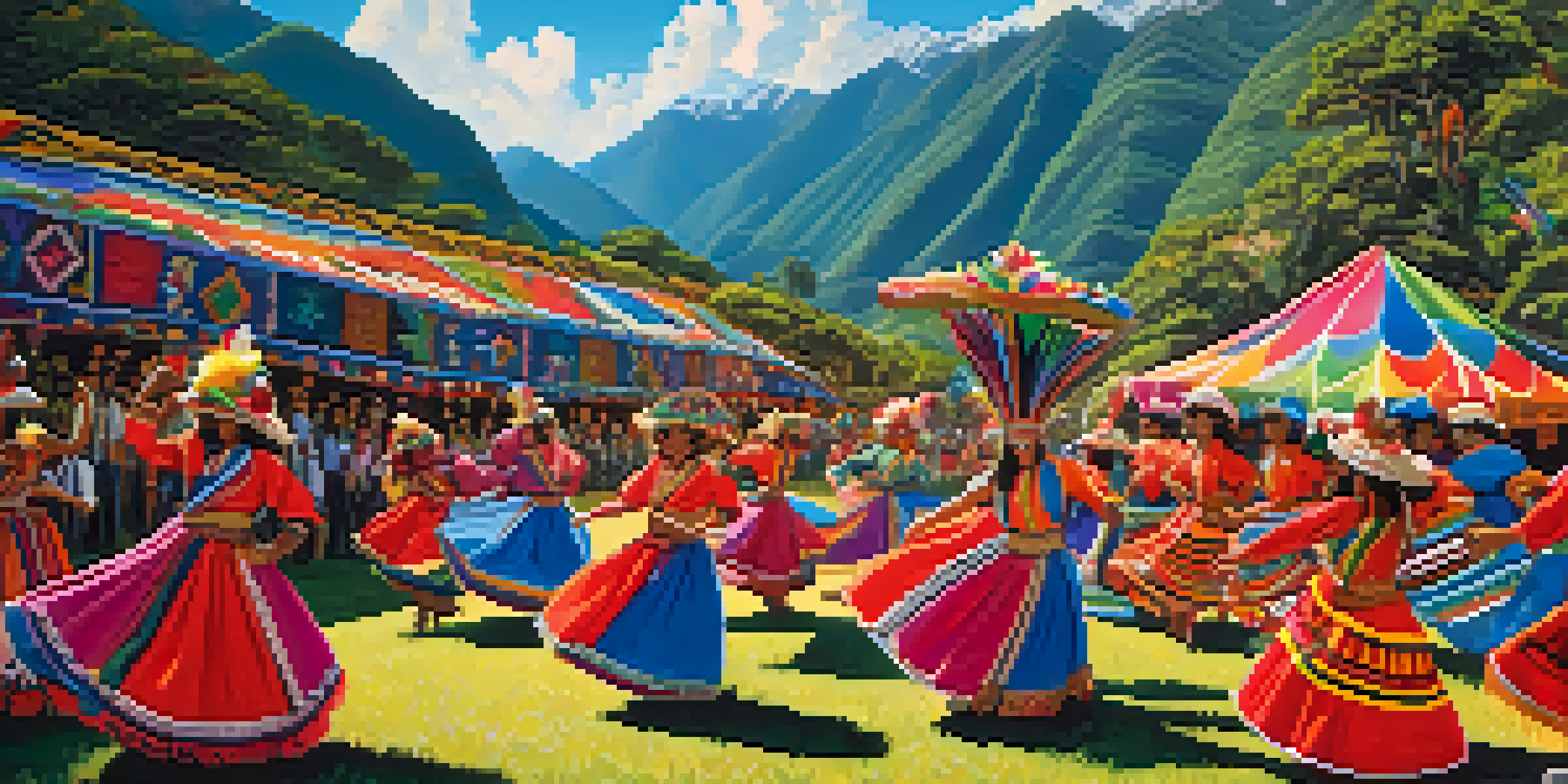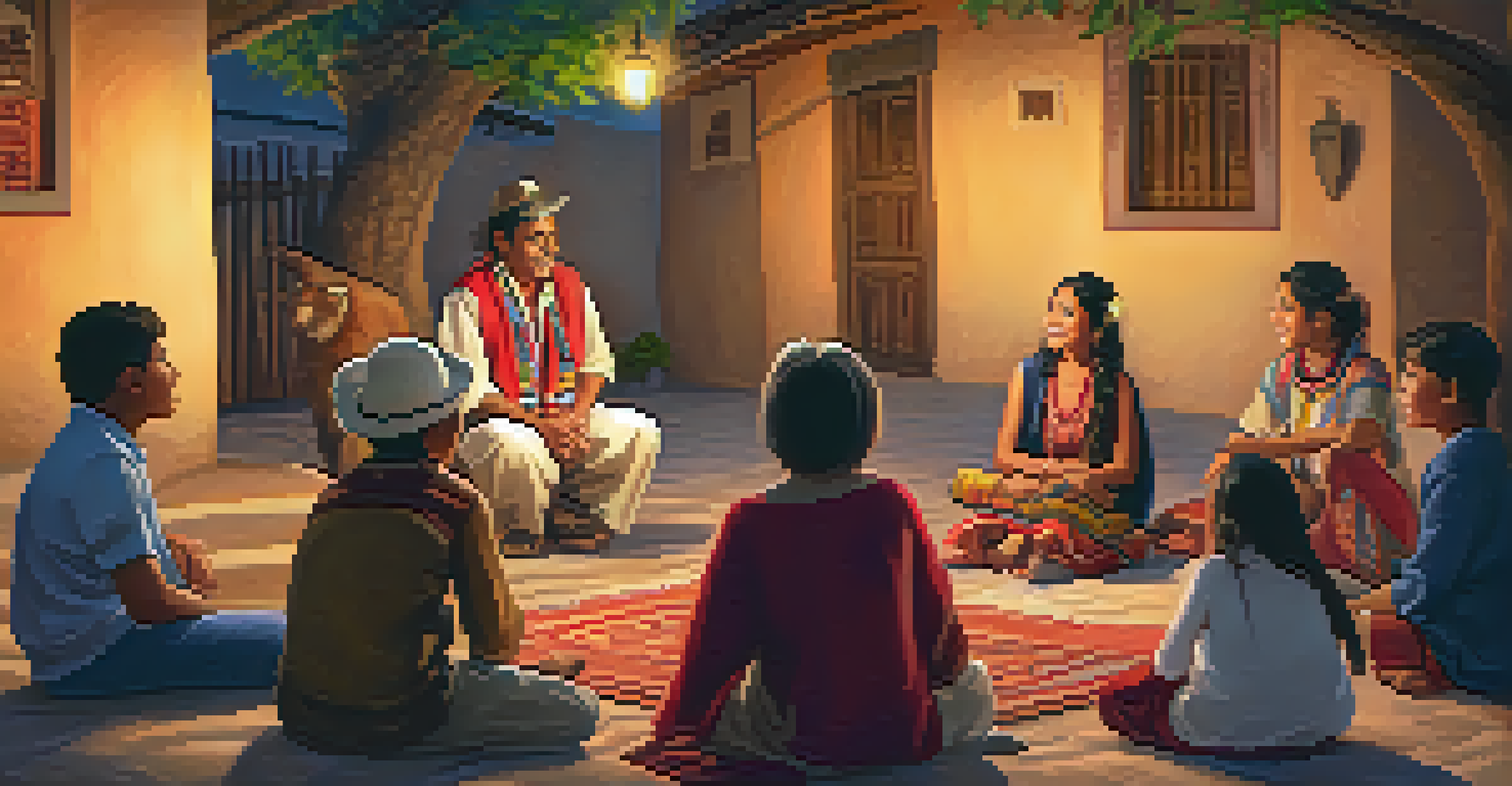The Influence of Peruvian Folklore in Global Storytelling

Understanding the Rich Tapestry of Peruvian Folklore
Peruvian folklore is a vibrant tapestry woven from diverse cultures, including Indigenous, Spanish, and African influences. This rich heritage has produced a variety of myths, legends, and storytelling traditions that reflect the country's unique history and values. From the tales of the Inca civilization to the colorful stories of the Amazon, these narratives are not just entertainment; they embody the beliefs and wisdom of generations.
Folklore is the heart of a culture, a way to pass down wisdom through generations.
One of the most fascinating aspects of Peruvian folklore is its ability to adapt and evolve. As different cultures intersected over the centuries, they brought new elements to traditional stories, creating a dynamic narrative landscape. For instance, the legend of El Diablo, which varies significantly across regions, showcases how local interpretations can breathe new life into age-old tales.
This adaptability makes Peruvian folklore a treasure trove for storytellers around the globe. By reflecting universal themes such as love, conflict, and morality, these stories resonate with audiences far beyond their geographical origins.
Key Themes in Peruvian Folklore and Their Global Resonance
At the heart of many Peruvian folktales are themes that echo across cultures, such as the struggle between good and evil, the importance of nature, and the quest for identity. These universal themes make the stories relatable, allowing them to transcend cultural barriers. For example, the tale of Pachamama, the Earth goddess, emphasizes respect for nature, a message that resonates strongly in today's environmental discourse.

Similarly, stories of heroes and demigods, like the legendary figure of Viracocha, embody the timeless quest for courage and wisdom. These narratives not only entertain but also inspire individuals to reflect on their own lives and challenges. By tapping into these shared human experiences, Peruvian folklore has made its mark on global storytelling.
Peruvian Folklore's Cultural Fusion
Peruvian folklore is a dynamic blend of Indigenous, Spanish, and African influences, adapting over time to reflect diverse cultural narratives.
As writers and creators adapt these themes into their own works, they contribute to a richer, more diverse narrative landscape. This cross-pollination of ideas enhances creativity and encourages new interpretations, allowing Peruvian folklore to flourish in contemporary storytelling.
Cultural Exchange: How Folklore Travels
Cultural exchange has played a significant role in the dissemination of Peruvian folklore around the world. As people migrate and share their stories, they carry with them the rich traditions of their homeland. This exchange often leads to a blending of narratives, where elements of Peruvian folklore are incorporated into other cultural contexts, creating something entirely new.
Stories are the most powerful tool we have to connect, heal, and inspire change.
For instance, the popularization of Latin American music has introduced a wider audience to the stories behind traditional songs and dances. Artists often draw inspiration from folkloric themes, weaving in elements from their heritage while appealing to a global audience. This fusion not only preserves the essence of Peruvian folklore but also showcases its relevance in modern expressions of art.
Moreover, festivals celebrating Peruvian culture, such as Inti Raymi or the Festival de la Vendimia, attract international attention, providing a platform for these stories to be shared. As people engage with these events, they become ambassadors of Peruvian folklore, spreading awareness and appreciation for its rich narrative traditions.
The Role of Literature in Preserving Folklore
Literature serves as a vital tool for preserving and sharing Peruvian folklore. Many authors, both local and international, have taken inspiration from these traditional tales, incorporating them into novels, short stories, and poetry. By putting these narratives into written form, they ensure that future generations can access and appreciate the depth of Peruvian cultural heritage.
A notable example is the works of José María Arguedas, whose novels often reflect the complexities of Peruvian identity through folklore. His storytelling not only honors the traditions of his ancestors but also invites readers to explore the rich cultural landscape of Peru. Such literature acts as a bridge, connecting the past with the present.
Universal Themes in Folktales
Key themes in Peruvian folklore, such as the struggle between good and evil and respect for nature, resonate globally, making these stories relatable across cultures.
Furthermore, the rise of digital platforms has made it easier than ever for these stories to reach a global audience. E-books, online articles, and social media allow for the rapid dissemination of folklore, enabling a new generation of storytellers to engage with these narratives creatively.
Visual Arts: Illustrating Folkloric Narratives
The influence of Peruvian folklore extends beyond literature into the realm of visual arts, where artists visually interpret these rich narratives. Through paintings, sculptures, and illustrations, they bring to life the characters and themes of folklore, making them accessible to a broader audience. This visual representation helps to capture the essence of the stories, often evoking emotions that text alone cannot convey.
For example, the vibrant colors and intricate designs found in traditional Peruvian textiles celebrate folklore by depicting scenes from popular legends. These artworks not only serve as a form of storytelling but also as a means of cultural expression and identity. By showcasing these narratives through visual mediums, artists play a crucial role in keeping folklore alive.
Additionally, contemporary artists are increasingly fusing traditional motifs with modern techniques, creating a dialogue between past and present. This blending of styles not only honors the origins of Peruvian folklore but also invites new interpretations that can resonate with diverse audiences worldwide.
Film and Theatre: Bringing Folklore to Life
The world of film and theater has embraced Peruvian folklore, bringing these age-old stories to new audiences through the power of performance. Movies and stage productions often adapt folklore, infusing it with modern storytelling techniques while retaining its cultural essence. This approach not only entertains but also educates viewers about the richness of Peruvian heritage.
Consider films like *The Milk of Sorrow*, which draws on themes of folklore to explore the complexities of identity and memory in contemporary Peru. Such works highlight how traditional stories can be reinterpreted to address modern social issues, making them relevant to today's audiences. This connection between past and present enriches the cinematic experience.
Modern Platforms Preserve Folklore
Digital media and literature play crucial roles in preserving and sharing Peruvian folklore, ensuring its relevance for future generations.
Moreover, theater companies often stage performances based on folkloric tales, captivating audiences with live interpretations of these narratives. These productions create a shared experience, inviting viewers to engage with the stories on a deeper level, fostering a sense of community and connection through the art of storytelling.
Looking Ahead: The Future of Peruvian Folklore in Storytelling
As we look to the future, the influence of Peruvian folklore on storytelling is poised to grow even stronger. With the increasing globalization of culture, there is a growing appetite for diverse narratives that reflect different perspectives. This presents an opportunity for Peruvian folklore to shine on the world stage, inspiring new stories and adaptations.
Emerging creators and storytellers are harnessing the power of digital media to share these narratives in innovative ways. From podcasts to web series, new platforms allow for the exploration of folklore in formats that appeal to younger audiences. This evolution ensures that the stories remain relevant and accessible, fostering a new generation of storytellers.

Ultimately, the future of Peruvian folklore in global storytelling hinges on collaboration and exchange. By continuing to share these rich traditions while embracing modern storytelling techniques, we can ensure that the essence of Peruvian folklore endures, enriching the global narrative landscape for years to come.